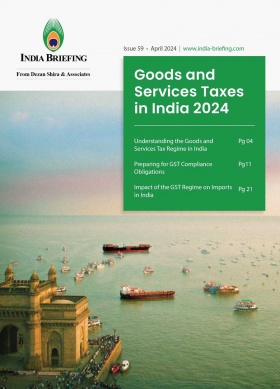End of India-China Border Standoff Signals Hope for Cross-Border Business Engagement
A diplomatic thaw between India and China appears to have been reached at the BRICS Summit in Kazan, Russia, after a reset was discussed following years of border tensions spilling over into the economic, commercial, and business spheres. Key sectors in India, including manufacturing and infrastructure, are now on wait-and-watch mode to see whether normalization of ties with China takes place and direct flights and visa services resume.
After years of prolonged tension between Asia’s two largest economies, India and China have reached a landmark agreement to end their military standoff in the region of Ladakh. Indian Prime Minister Narendra Modi and Chinese President Xi Jinping held a significant bilateral discussion during the 16th BRICS Summit in Kazan, Russia, marking the first formal meeting between the two leaders in five years. The meeting, which lasted 50 minutes, focused on de-escalating tensions along the Line of Actual Control (LAC), the disputed boundary between the two nations.
Key outcomes of the Modi-Xi dialogue
According to media reports, Modi and Xi have agreed to resume Special Representatives’ talks on the India-China boundary issue. The talks aim to establish a long-term strategy for managing border disputes, enhancing strategic communication, and fostering cooperation on mutual development challenges. India’s National Security Advisor Ajit Doval and China’s Foreign Minister Wang Yi will act as the Special Representatives. While they have met informally at multilateral events, this will be their first formal engagement in their designated roles.
An official press release from India’s Prime Minister’s Office (PMO) stated that both leaders welcomed the recent agreement for complete disengagement and resolution of post-2020 border issues. Prime Minister Modi stressed the importance of effectively managing disputes to maintain peace and stability, asserting that differences should not disrupt broader bilateral relations.

The PMO noted that the Special Representatives will soon convene to oversee peace and stability in border areas and seek a fair, mutually acceptable resolution to the boundary issue. Existing dialogue mechanisms, including those involving foreign ministers and other officials, will be leveraged to stabilize and rebuild bilateral relations.
Both leaders affirmed that stable, predictable relations between India and China, as the two largest neighboring nations, would positively impact regional and global peace. They emphasized the need for a strategic, long-term approach to bilateral relations, improved communication, and cooperation, particularly in addressing developmental challenges. Xi highlighted the importance of increasing dialogue and managing differences to promote a multipolar world.
Timeline of the India-China border dispute
India and China have long disputed their 3,488-km border (approximately 2167 miles), known as the Line of Actual Control (LAC). The border conflict traces back to the colonial era. We note key events in the below timeline:
- 1954: The Panchsheel Agreement was signed, recognising China’s sovereignty over Tibet but leaving boundary issues unresolved.
- 1962: A war broke out between the two nations over Ladakh and Arunachal Pradesh.
- 1967: The Nathu La clashes marked a rare victory for India.
- 1986-87: Tensions escalated over the Sumdorong Chu Valley standoff, later diffused through diplomatic engagement.
- 1993: Both sides signed an agreement to maintain peace along the LAC.
- 2013: A major standoff occurred in Ladakh’s Depsang plains.
- 2017: A 73-day military standoff over the Doklam region raised tensions.
- 2020: The Galwan Valley clash resulted in casualties on both sides, leading to a long-term standoff.
- 2021-2023: Both sides made progress in disengagement talks, though tensions remained.
- 2024: On October 21, 2024, Indian Foreign Secretary Vikram Misri announced that military negotiators had reached a significant agreement to resolve the eastern Ladakh standoff, focusing on patrolling arrangements in the Depsang and Demchok areas. However, China’s statement following the Modi-Xi meeting avoided the term “agreement,” referring instead to “important progress in resolving relevant issues.” As reported in Xinhua: “Modi put forward ideas and suggestions on improving and developing bilateral relations, to which Xi Jinping agreed in principle.”
Background
India-China relations have significantly worsened since the deadly June 2020 clash in the Galwan Valley, which resulted in the deaths of at least 20 Indian and four Chinese soldiers. This confrontation marked the first fatalities between the two nations in decades and led to a prolonged standoff along their disputed Himalayan border, with both sides deploying tens of thousands of troops supported by tanks, artillery, and fighter jets.
Tensions revolve around the poorly defined Line of Actual Control (LAC), where the changing landscape frequently brings soldiers into close proximity, heightening the risk of conflict. Infrastructure development along the LAC, particularly India’s construction of a new road to a high-altitude airbase, has been a major factor in escalating tensions.
In December 2022, Indian and Chinese troops clashed in the Tawang sector of Arunachal Pradesh, resulting in minor injuries—the first significant confrontation since the Galwan Valley incident. Earlier, in January 2021, a clash near Sikkim also led to injuries on both sides. Tensions flared again in September 2021 when China accused India of firing shots at its troops, a claim India denied, stating that China fired into the air. This incident would have marked the first use of gunfire at the border in 45 years, violating a 1996 agreement banning firearms along the LAC.
China’s increasing share in India’s imports
Following the agreement on LAC patrolling, there is optimism for improved trade relations between India and China. Businesses on both sides anticipate a revival in economic activity. Currently, China is India’s largest trading partner and the leading exporter of industrial equipment to the country.
According to Bloomberg, China’s share of India’s imports has increased from 21 percent to 30 percent over the past 15 years, underscoring the significance of their economic ties.
|
Commodity |
India’s Imports from China (%) |
|
Textile, clothing |
41.50 |
|
Electronics, telecoms, electrical products |
38.70 |
|
Machinery |
38.50 |
|
Chemicals and pharmaceuticals |
28.70 |
|
Plastics |
25.10 |
|
Automobile |
23.20 |
|
Iron, steel, base metal |
16.60 |
Source: GTRI report, Bloomberg
China dominates India’s industrial imports—across textile, electronics, and machinery segments. Despite efforts to boost local manufacturing in sectors like electronics and telecommunications, Indian firms depend on China-sourced components and industrial goods.
|
India-China Trade Relations Year-on-Year (Value in US$ Million) |
|||||
|
Year |
FY 2019-20 |
FY 2020-21 |
FY 2021-22 |
FY 2022-23 |
FY 2023-24 |
|
Export |
16,612.75 |
21,187.15 |
21,259.79 |
15,306.10 |
16,658.91 |
|
%Growth |
– |
27.54 |
0.34 |
-28.00 |
8.84 |
|
Import |
65,260.75 |
65,212.25 |
94,570.57 |
98,505.77 |
101,735.76 |
|
%Growth |
– |
-0.07 |
45.02 |
4.16 |
3.28 |
|
Total trade |
81,873.50 |
86,399.40 |
115,830.36 |
113,811.87 |
118,394.67 |
|
%Growth |
– |
5.53 |
34.06 |
-1.74 |
4.03 |
Source: Department of Commerce, Ministry of Commerce and Industry, GoI
Towards reconciliation: Signs of improved India-China relations in 2024
After the deadly border clash in 2020, relations between India and China deteriorated drastically. However, a gradual shift towards stability in border areas and an increase in commercial ties has been observed more recently.
A report from the Economist on July 18, 2024, indicates that signs of this shift emerged in late 2023, when India eased visa restrictions for Chinese professionals in specific industries. Modi also moderated his rhetoric regarding China, expressing optimism for border stability. In April 2024, India’s defense minister described ongoing border talks as “progressive.” In May, China appointed a new ambassador to India, Xu Feihong, after an 18-month gap. The ambassador has been actively working to enhance bilateral ties, while China has adopted a low-profile approach regarding sensitive issues such as Taiwan and the Dalai Lama’s meetings with American officials.
A key factor contributing to this improvement is the implementation of a new system for managing border tensions, which has established “buffer zones” where troops from both sides withdraw and cease patrolling.
Moreover, as India aggressively pursues economic growth through emphasis on manufacturing and infrastructure building, it is dependent on Chinese technology, investment, and expertise. On its part, China faces its own economic challenges and rising global trade barriers.
From a trade war with the US to seeking control over Taiwan and maintaining influence in Myanmar to a troubled domestic economy, China is fighting on many fronts. In India, the border stand-off was political fodder for the opposition to attack Modi even as Indian businesses have been pushing for more trade, investments and technicians from China. – Sudhi Ranjan, Bloomberg
Impact of India-China border tensions on businesses
Since 2020, India has imposed restrictions on Chinese smartphone apps and websites, increased tax and audit scrutiny of Chinese companies, and enacted foreign direct investment (FDI) rules raising clearance thresholds. Nevertheless, imports from China have continued to grow unabated. In 2023-24, China overtook the U.S. to become India’s top trading partner, with imports from China rising to US$101 billion—a significant increase since 2020.
There are growing expectations for an expansion of commercial ties, although diplomatic relations between the two countries remain sensitive. Indian and Chinese companies are increasingly forming joint ventures in sectors such as electric vehicles and mobile phone manufacturing, supported by government subsidies. For example, the Chinese state-run company SAIC Motor has partnered with India’s JSW Group to produce electric vehicles, targeting a substantial share of the Indian market by 2030.
Western firms looking to relocate manufacturing from China to India may not sever ties with Chinese companies entirely. For instance, U.S.-based electronic giant Apple has begun producing some of its iPhones in India, while several Chinese component manufacturers are establishing operations in India to supply Apple.
Additionally, Chinese machinery, such as cranes, remains critical for India’s infrastructure, given its widespread use in Indian ports.
Meeting the needs of India’s electronics manufacturers
Electronics companies are optimistic that improved bilateral relations will lead to faster visa approvals and investments, which are crucial for meeting the industry’s time-to-market demands. Chinese smartphone brands also anticipate that reduced border tensions will result in fewer regulatory crackdowns, allowing them to focus on their long-term business strategies in India.
The Indian electronics manufacturing sector is optimistic that easing border tensions between India and China could accelerate pending technology transfers, planned investments from Chinese firms, and the movement of capital goods. However, some executives believe Chinese companies will remain cautious about investing in India and sending their executives until the trust deficit is adequately addressed.
Domestic electronic manufacturers believe this de-escalation could enable the Indian industry to collaborate with reliable Chinese companies while ensuring national security. Such collaboration would help build a robust supply chain and foster trust between the two nations for mutual benefit, particularly as Indian electronics manufacturers of products ranging from wearable devices to telecom equipment rely heavily on Chinese raw materials and intermediate goods.
Since 2020, the domestic electronics industry has been affected by delayed visa approvals and restrictions on capital goods, despite India’s continued dependence on Chinese capabilities.
In a recent meeting with stakeholders on October 16, 2024, the central government acknowledged these concerns and promised to expedite visa approvals for Chinese executives under the e-visa scheme within 15 days, contingent upon the submission of valid documents. Slow visa approvals have hindered India’s efforts to deepen its manufacturing capabilities, as Chinese engineers necessary for equipment installation have faced entry restrictions.
Industry leaders are also hopeful that planned investments and technology transfers from China will now be fast-tracked under “Press Note 3,” which mandates government scrutiny of FDI from bordering nations. Although immediate investments from Chinese companies may be delayed due to caution, executives believe that trust-building measures will ultimately facilitate progress.
India has also recently approved several partnerships between Indian and Chinese companies. For example, Dixon Technologies has partnered with China’s Longcheer and HKC to establish a display assembly plant in India. Similarly, Micromax’s Bhagwati Enterprise is collaborating with Chinese ODM Huaqin to enhance design capabilities for smartphones, IT hardware, and telecom equipment in India.
About Us
India Briefing is one of five regional publications under the Asia Briefing brand. It is supported by Dezan Shira & Associates, a pan-Asia, multi-disciplinary professional services firm that assists foreign investors throughout Asia, including through offices in Delhi, Mumbai, and Bengaluru in India. Dezan Shira & Associates also maintains offices or has alliance partners assisting foreign investors in China, Hong Kong SAR, Vietnam, Indonesia, Singapore, Malaysia, Mongolia, Dubai (UAE), Japan, South Korea, Nepal, The Philippines, Sri Lanka, Thailand, Italy, Germany, Bangladesh, Australia, United States, and United Kingdom and Ireland.
For a complimentary subscription to India Briefing’s content products, please click here. For support with establishing a business in India or for assistance in analyzing and entering markets, please contact the firm at india@dezshira.com or visit our website at www.dezshira.com.
- Previous Article What Uttar Pradesh’s New Master Plans for Noida and YEIDA Mean for Investors
- Next Article Navigating India-Türkiye Relations: Opportunities and Challenges








